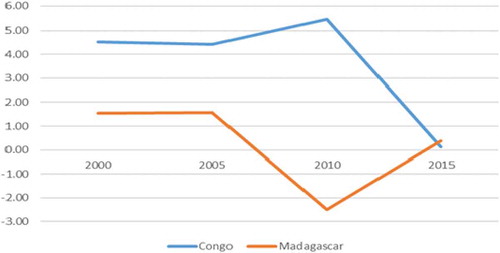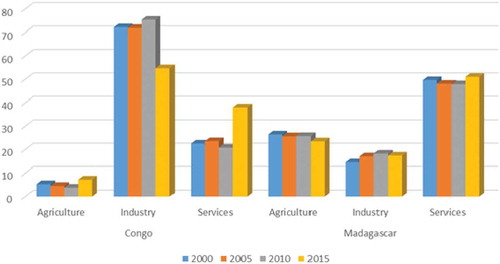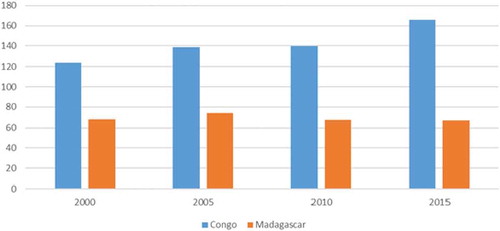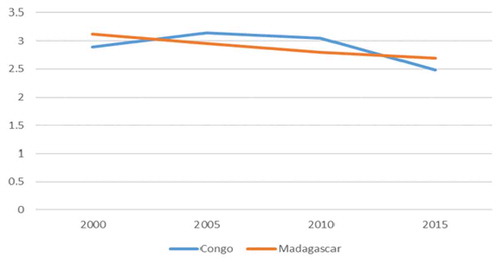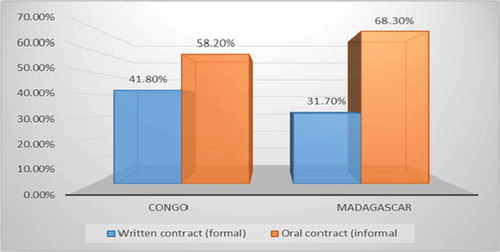ABSTRACT
The present study compares the educational attainment level among the youth in two Sub-Saharan African countries, namely; the Democratic Republic of the Congo (DRC) and Madagascar, with their status in work. The study employed data from the school-to-work transition survey of the International Labour Office, 2015. This study reveals that in the two countries investigated, that youths face several challenges when negotiating their move to employment because the educational attainment of the majority of them is deplorable. Financial burdens and exam failures are the critical reasons why the youth of these two countries leave school early and engage in low-quality jobs to secure their living. Besides, young wage workers are most likely to be exposed to exploitation, since their employment is usually based on an oral contract.
KEYWORDS:
Introduction
Recent data on unemployment among youths shows that developing countries, in general, and in Africa, in particular, are the regions most affected by the youth unemployment phenomenon. The rate of youth unemployment in Africa is higher, as compared to the world as a whole. For example, in 2017, the youth unemployment rate in Africa, which stood at 12.5%, was about four times the rate of Southeast Asia. Even in Africa, the severity of this problem varies between the different sub-regions, between countries and also within individual countries over time (see in the Appendix). Most importantly, this problem may be exacerbated in the future, given the expectation that 29% of the world’s youth population will reside in Africa by the year 2050 (World Bank, Citation2014).
High leakage in the early stages of the education cycle is one of the crucial causes of problems in the transition to the labour market for youth. Low levels of entrepreneurship worsen the situation, as well as, the unwillingness of youth to join vocational education to gain the skills necessary for widely available low- to mid-skilled jobs (Atchoarena & Delluc, Citation2001; Awogbenle & Iwuamadi, Citation2010; Oketch, Citation2007; World Economic Forum, Citation2017). As a result, youths face lengthy transitions from school to employment and are often discouraged from maintaining their job search. The move to work is considered as one of the most substantial changes for anyone in their entire life. A fruitful transition, or participation, in the workplace, often brings on an individual basis, a variety of benefits, such as financial self-sufficiency, social networks, or self-worth (Tilbury et al., Citation2011).
Moreover, with higher-quality jobs, it is expected that the labour market will achieve higher productivity. Thus, the transition to the labour market for youths is not only about them having something to do, as well as, the length of time between the end of schooling to their first entry into a job but also the quality of the jobs that they enter into is also worth considering. ILO (Citation2013a) defines the transition to the labour market as the journey of young people, aged from 15 to 29, from the end of schooling (either upon graduation or early exiting without completion) to their first stable or satisfactory job. Permanent and adequate position, the qualitative ingredients in the transition to the labour market for youths, has turned out to be an emerging subject for discussion for academicians and policymakers in the literature.
Generally, transitions are recognized as complicated and challenging, and often require an initial drop in performance, especially when the transition is from a lower to a higher level (Tran, Citation2017; Van Geert, Citation1994). The process of moving from school or university to the processes of employment require youths to learn new tacit knowledge regarding the workplace. This knowledge, which comprises cognitive and noncognitive skills, is needed and required for youths to participate effectively in the labour market. (Cawley et al., Citation2000, Citation2001; Capatina, Citation2014; Heineck, Citation2011; Murnane et al., Citation1995; Sternberg et al., Citation2000; Weiss, Citation2010). However, without a specific and sufficient level of knowledge, learning is not an easy task. Therefore, adequate preparation and guidance for youths before starting to search for a job is essential (Artess et al., Citation2011; Chapple & Tolley, Citation2000; Creed et al., Citation2003; Harvey, Citation2005; Helyer et al., Citation2011; Lowden et al., Citation2011; Rust & Froud, Citation2011; Tran, Citation2017). Nonetheless, we have to keep in mind that many stakeholders (i.e. schools, universities, parents, families, and the social networks of friends and acquaintances) may get involved in preparation and guidance for youths. It seems that the transition to employment for youths appears to be a multi-faceted process comprising various factors, from personal aspects to the interference of several labour market factors and other contextual and environmental influences.
The term “employability“ appeared recently in the dialogue regarding the transition to employment or the engagement of young people in the labour market. Usually, employability is understood to be ‘the capability to gain initial employment, to maintain employment and to obtain employment, if required (Hillage & Pollard, Citation1998). Employability was defined by Moreland (Citation2006), as a set of skills, knowledge, and personal attributes that let an individual be more likely to secure and be successful in their selected occupations. In general, employability is most likely associated with the level of knowledge and skills that one can reach before starting the transition to work. With the process of economic globalization and integration that shapes the region today, knowledge and ability turn out to be important factors related to the employability of youth.
Nonetheless, as mentioned before, in addition to knowledge, gaining employment opportunities is highly dependent on other factors comprising; labour market regulations (Clarke, Citation2007), personal circumstances (class, gender, ethnicity, place of living, individual characteristics and relationships), as well as the ability for job flexibility and mobility (McQuaid, Citation2006). In other words, the transition to employment involves not only the level of suitability, in terms of the knowledge and skills youths possess, but also their circumstances and characteristics
The issue of youth unemployment in the region has been addressed in several studies, however, all of these previous studies have investigated this matter by utilizing aggregated (macro) variables (Anyanwu, Citation2013, Citation2014; Awad, Citation2019; Kabbani & Ekta, Citation2005; Mabala, Citation2011; Thieme, Citation2010). It is important to note, however, that the youth unemployment rate does not provide a full description of youth’s difficulties in the labour market. Most importantly, even the data on employment among youths provides no information concerning whether their jobs are secure, stable, and decent. The present study will, instead, rely on updated microdata that describes, in detail, the movement of youths from school to work. More specifically, the present study will use data from the ‘school-to-work transition survey’ developed by the International Labour Office, in cooperation with the Mastercard Foundation, under the W4Y project (Work4Youth). This paper aims to examine the relationship of ‘human capital’, or the employability assets that young people in two sub-Saharan African countries (SSA) could develop, before making their transition to employment and the quality of jobs that they could gain access to. Specifically, this paper aims to look at educational attainment among youths in SSA countries and their status in the labour market. It also intends to illustrate the current economic conditions and labour markets in the countries examined to bring about a clearer image regarding the opportunities, as well as, the challenges for youths when preparing themselves to join the labour market.
The school-to-work transition survey covered several countries in SSA over different periods. Our criteria, in the selection of the countries to be investigated, was based on two conditions – first, the availability of harmonized data. Second, and to be consistent, the year of the survey should be the same across the selected countries. We found that only the DRC and Madagascar, met our criteria. Interestingly, the aggregate data on the unemployment rate showed that the DRC’s youth unemployment rate was relatively high (22.8%), while it was only 2.7% in Madagascar as per 2018 (World Bank Group, Citation2019). Therefore, the experience of these two countries with the matter of youth unemployment is to some extent relevant to all of the countries in the region.
The present study is intended for the use of policymakers and social partners involved in the implementation of national youth-related policies and programs, as well as for international and non-governmental organizations involved in the development of responses at the regional level. The remainder of this paper is organized as follows. Section 2 presents the economic and demographic structure of the two countries. Section 3 outlines the methodology. The results are presented in Section 4. Finally, Section 5 presents the discussion and conclusion of the present study and provides policy recommendations.
Socioeconomic context
Economic growth
Since the status of youth and the performance of the labour market are mainly affected by the structure of an economy, this section aims to highlight the relevant components of the economy in each country. shows the per capita annual growth rate for each country during the period 2000–2015. indicates that, overall, and before 2015, the DRC performed better than Madagascar. However, since 2010, significant changes have occurred in each country. More specifically, since 2010, Madagascar started to record positive and substantial growth in the per capita GDP. In contrast, during the same period, the economy of the DRC started to deteriorate significantly. By the end of 2015, both countries recorded the same growth rate in the per capita GDP.
The contribution of the critical components of an economy to the GDP is considered as one of the factors that affect the structure of the labour market. In general, while the industrial sector is the dominant sector in the DRC, the services sector is the dominant sector in Madagascar. After 2010 significant changes in the structure of the DRC’s economy took place. More specifically, as shown in , the share of the industrial sector decreased from 75% in 2010 to 55% in 2015, and in the same period, the share of the services sector increased from 20% in 2010 to 38% in 2015. The agricultural sector is the second-largest economic sector in Madagascar, which contributed, on average, 24% of the GDP during the period 2000–2015. With such economic structures, one can expect that most workers, including youths, are engaged in the services and the agriculture sectors in Madagascar, while in the DRC workers are concentrated in the industrial sector. Medina et al. (Citation2016) estimated the size of the informal economy for Sub-Saharan African countries over 24 years using the Predictive Mean Matching (PMM) method. The results show that the informal economy in Sub-Saharan Africa remains among the largest in the world, although this share has been very gradually declining.
Concerning the integration of each country with global markets, clearly indicates that the DRC is more open to the world economy than Madagascar. Over time, it is clear that the DRC has implemented the necessary policies to become more integrated with the global economy. The economic globalization index score for the DRC increased by 127% during 1970–2019, while during the same period, it increased by 77% only for Madagascar (Gygli et al., Citation2019). This index offers an alternative measurement to trade liberalization by accounting the various dimensions of trade policies. The methodology for computing the EGI mandates that the two indices used to construct the index are actual outflow and restrictions, weighted equally at 50%. The actual outflow index includes the following variables as a percentage of GDP: trade (weighted at 21%); FDI (weighted at 81%); stocks portfolio investment (weighted at 24%); and income payments to foreign nationals (weighted at 27%). The restriction index includes data on hidden import barriers (weighted at 24%); mean tariff rates (weighted at 27%); taxes on international trade (as a percentage of current revenue) (weighted at 26%); and capital account restrictions (weighted at 23%). The value of the EGI ranges from zero to 100 in which high score indicates more openness, and vice versa (Dreher et al., Citation2008). A growing amount of evidence has shown that openness to the worldwide market or to regional markets affects the rate of youth unemployment in several ways, depending on different factors (Awad, Citation2019).
Demographic
It’s recognized that population growth is one of the critical factors that affect the structure of the population. As per figure 4, before 2003, the population of Madagascar grew faster than that of the DRC, however, in 2004, the rate of population growth was the same in both countries. From 2005 until 2012, the rate of population growth was higher in the DRC, as compared to that of Madagascar. However, since 2013, the rate of population growth in the DRC has shown a decreasing trend while that of Madagascar has been relatively high and stable.
Concerning the unemployment rate among youths, shows that, in general, youths, regardless of gender, suffered more from unemployment in the DRC, as compared to Madagascar. However, the unemployment rate among youths of both genders decreased in the DRC during the period 2000–2015. In Madagascar, the unemployment rate for both males and females fluctuated at under 10% over the same period.
Figure 5. Unemployment, youth (% of labour force ages 15–24), by gender.
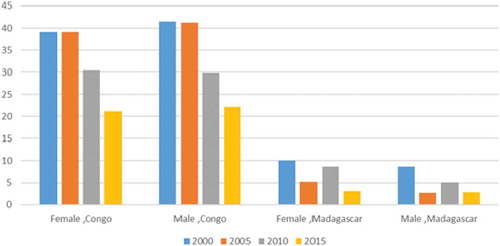
Regarding gender equality among waged and salaried workers, shows high inequality between males and females in Madagascar. The share of females in the DRC in the category of waged and salaried workers is larger, as compared to females in Madagascar. In Madagascar, during the period 2000–2015, approximately 33–35% of the employed people (working for wages or salary) were male. During the same period, only 15–17% of the employed people (working for wages or salary) were females. In the DRC, during the period 2000–2015, the share of females in this category of workers was marginally higher, as compared to males.
Figure 6. Wage and salaried workers, (% of employment), by gender.
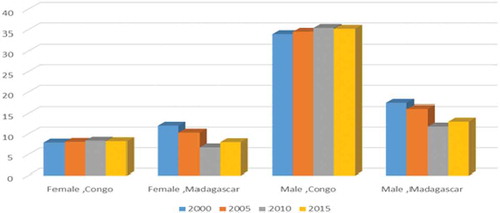
During the period 2000–2015, indicates that the labour force participation rate (LFPR) for youths in Madagascar was relatively high, as compared to the DRC. More specifically, during this period the LFPR in Madagascar remained above 75%, but during the same period, this rate froze at 40% in the DRC. The relatively high growth in the population in the DRC during this period, as previously mentioned, may explain, even partly, the low share of youths in the LFPR.
Research methods
This study uses data from the school-to-work transition surveys that were conducted in the two countries during 2015. The survey was developed by the International Labour Office, in cooperation with the Mastercard Foundation, under the W4Y Project (Work4Youth) to create more and detailed labour market information, specific to youths, in developing economies. The survey focused, in particular, on the transitional journey of youths to the labour market. In the DRC, the survey was conducted by the General Office of Qualifying Training and Employment, in Madagascar, the survey was performed by the National Institute of Statistics.
The W4Y survey in 2015 covered samples of 3276 and 5044 young people, aged from 15 to 29, in the DRC and Madagascar respectively. All of the data used in this study were gathered from the school-to-work surveys (STWS) carried out in these two countries. The STWS survey provided rich and reliable data, during the transition to work, for the youth in these two countries. The STWS data offered two types of information about youth; the first part described the educational attainment of youths, against their residence and gender. The second part compared the educational attainment of youths, as in the first part, with the potential jobs that they could consider when entering the labour market. Thus, the information in the first and second parts of the survey help in investigating the link between youth educational attainment and employment status. Firstly, this study explored the educational attainment of the youth in the two countries examined and their employment status, after that, the study compared the educational attainment of the youths with their status in work. Finally, a regression model, based on the standard Mincerian earnings equation, as used by several studies in research regarding the impact of education on wages (e.g. Blien & Phan, Citation2009; Tran, Citation2017), was implemented.
Findings
General information about the sample
The distribution of youth by sex, by area of residence and unemployment, is displayed in . The distribution of the sample, according to gender, is to some extent the same in both countries, where the ratio of males and females is equal. However, concerning the area of residence, rural youth represent the majority of the sample, for the case of Madagascar, while the opposite is true in the case of the DRC. For the unemployment rate, in Madagascar, the microdata from this survey supported the aggregate data that has been previously discussed, while for the DRC, the aggregate data may have overestimated the rate of unemployment among youths.
Table 1. Distribution of youth by sex, by area of residence and unemployment.
Youth educational attainment
reflects disappointing information regarding the status of youth education in both of the countries examined. In the DRC, only 18% of youths completed their education, while the rate for Madagascar was 27%. In Madagascar, approximately half of the youths (49%), either, left before graduation/completion of a training program or never attended school or training. In the DRC, this category of youth constituted 31.3%. This signalled that inadequate human capital had been formed from educational attainment, among the young, in both countries.
Table 2. Youth education status.
Nonetheless, when looking at educational attainment among youths who were not engaged in any course of study, the results were even more disappointing (see, for the DRC, for Madagascar). The proportion of youths whose highest qualification was the primary education level in each country (25.3% in the DRC, 48% in Madagascar). The highest drop-out rate was among youths during primary school (37.2% in the DRC, 67.4% in Madagascar) and lower secondary school, 30% in the DRC and 25% for the secondary level in Madagascar. This information reflects the deplorable situation of human capital formation in these countries. Also, the information reflects the high drop-out rate from the schools in the early stages of education.
Table 3. Highest qualification among youth who were not attending school or training, Congo.
Table 4. Highest qualification among youth who were not attending school or training, Madagascar.
Economic reasons, in both countries, justify why youths leave school/training early (). The financial burden that young people from low-income families bore was another layer of pressure that caused them to leave school early and start working to earn money. However, this problem was more chronic in Madagascar than in the DRC, as approximately half of the youths in Madagascar mentioned that economic reasons were the main problem, compared to 34.2% in the DRC. The second reason to leave school/training early in Madagascar was that youths were not interested in education/training (17.9%), while in the DRC it was due to failed examinations (20.7%). The lack of interest in education and training in Madagascar appeared to be one of the most significant obstacles which took youth out of the educational system early. This negative attitude towards education indicated, even partially, the lack of aspiration among youths. The issue of how aspirations shape future-oriented activities have already been discussed in different conceptual and theoretical frameworks (Appadurai, Citation2004; D. Ray, Citation2006). These concepts are equally crucial to decisions regarding schooling and employment. In a more recent study, Genicot and Ray (Citation2017) showed that economy-wide outcomes determine aspirations, which in turn determine the incentives to invest in education. Thus, in each country, to help human capital formation and to encourage youths to attend and complete their educational journey, the best method is to improve their family’s economic condition.
Table 5. Youth left school before completion by reasons.
Before moving on to look at youth employment and to what extent such jobs are decent and secure, we first looked at the expectations regarding employment, from the perspective of the youths that we were studying. Show that, in both countries, a large proportion of youths were willing to work in the government/public sector (52.2% in the DRC, 74.2% in Madagascar). The main reasons for such a preference may have been; higher salaries and benefits, better working conditions, and greater job security in the government sector. In this respect, Bandara (Citation2018) using School to Work Transition Surveys (SWTS), during the period 2012–2013, for eight Sub-Saharan African countries, investigated what factors influenced youth labour market expectations. Using multinomial logit analysis, the study found evidence that youth education significantly affected youth employment expectations and employment.
Table 6. Youth perspective for future job.
Youth status in employment
Madagascar indicated a high employment rate among youths (as per ). 70.5% of youths were engaged in self-employment (own-account workers 26.9%) or doing unpaid family work (43.6%) (). Self-employment and unpaid family work are often considered different types of lowly productive, informal employment, which is popular in developing countries (Antonopoulos and Hirway, Citation2010; Campbell, Citation2013; Margolis, Citation2014). In the DRC, the story was not so different, as 50% of the employees were engaged in self-employment (own-account workers). However, in the DRC, 32.6% of youths were working for wages or in kind. Nonetheless, as we will see later, even the paid employment carried out by the participants of this study was not always decent employment. This finding implies that relying on aggregate data on employment may lead to misleading perceptions, since, as we mentioned previously, it doesn’t provide information regarding whether such jobs are secure, stable, and decent.
Table 7. Employment status among workers youth.
The data indicate that among the young workers who received wages or salaries for their work, 68.3% and 58.2% of them worked purely under oral contracts in Madagascar and the DRC, respectively (). These workers could not get access to a legal/formal employment contract, and, therefore, they could be made redundant any time without the protection of the law. Moreover, as indicated in , among the 499 wageworkers in Madagascar, only 13.2% received social security entitlements, 23.8% received paid sick leave, and 12.2% received pension insurance. The story is identical in the DRC where among the 371 wageworkers, only 25.1% received social security entitlements, 27.5% received paid sick leave, and 21.6% received pension insurance. This is undoubtedly not a good signal of stable, decent, and satisfactory employment.
Table 8. Fringe benefits young workers could get access to.
Education attainment and youth status in employment
In the DRC, only 59% of the employed young had a qualification at the secondary level of education or below which was a disappointing finding (see, as shown in ). Besides, a large proportion of the young with relatively higher levels of education (upper secondary school and above) had been absorbed as employees (working for someone else either for cash or in-kind), followed by the category of own‐account workers. The opposite was true for a large proportion of the young with less than an upper secondary school level of education who were engaged as own‐account workers, followed by employees (working for someone else either for cash or in-kind).
Table 9. Employment status by Educational attainment, Congo.
In Madagascar, as per , the situation was even worse, as the highest qualification for 65% of the employed was at the primary level of education or no qualification at all. However, on average, 58% of them were engaged in unpaid work (helping without pay in the business or farm of another household/family member). Most of the young workers at the secondary education level were absorbed as own‐account workers or were carrying out unpaid work. Most of the youths at the vocational, University and Post-graduate education level were working for someone else, either for cash or in-kind.
and show waged workers, by type of contract and level of educational attainment in the DRC and Madagascar, respectively. Surprisingly, in both countries, and on average, 80% of the workers in this category were working, either under an oral contract or under no contract at all. This means that the education level had no significant effect on the type of contract being used. This finding indicated that due to the kind of agreement, waged workers are more exposed to risk if they stopped working, regardless of the reason, as they may not be able to get access to any benefits generally associated with formal employment, such as sick leave, annual leave or social security entitlements.
Table 10. Employment status by Educational attainment, Madagascar.
Table 11. Wages Workers by type of contract and educational attainment, Congo.
Table 12. Wages Workers by type of contract and educational attainment, Madagascar.
The wage regression model () is based on the standard Mincerian earnings equation. For the DRC the results show that an increase in the number of workers with a qualification at the primary school education level will lead to a significant reduction in wages. However, an increase in workers with a qualification at the college-level will lead to a considerable increase in wages. For Madagascar, interestingly, the level of wages increased substantially with any level of education, even at the primary school level. The number of empirical studies that have tried to estimate the private return against different levels of education has grown significantly (see, Psacharopoulos & Patrinos, Citation2018, for updated literature). From these studies, it seems that there is a consensus on the fact that the returns are highest for primary education in a country with the lowest per capita income (Psacharopoulos & Patrinos, Citation2018). Theoretically, in the early stages of the development process, the demand for low skilled workers (those with primary education) will be relatively high compared to those with higher skills. However, in the last stage of development, the demand for workers will be the opposite. Thus, in our case, the difference between the impact of primary school education on wages between the two countries may be because of a difference in the level of development. A recent classification by the World Bank showed that while the DRC belonged to the lower-middle-income group, Madagascar was classified in the low-income group. This fact is consistent with the information indicated in . Thus, the private return on primary education is positive in Madagascar because of the lower per capita income in this country, as compared to that of the DRC.
Table 13. Wage Regression, Dependent variable log Wage.
Discussion and conclusion
The findings of this study reveal that the youths, in both of the countries examined, possessed low educational attainment or weak employability assets, and inadequate human capital when negotiating their transition from education to employment. Low educational attainment is a significant indicator of insufficient knowledge and skills that youth could develop to satisfy the increasingly demanding requirements of the labour market (Caraway, Citation2010; Tencati et al., Citation2010; Tran, Citation2017). Although the key factors that explain this situation vary between the two countries, economic reasons, as well as failed examinations, seem to be common elements in both countries. Tuition fees, and other school expenses (uniforms, Text books, transportation … … …, etc.) seem to be the main problem that prevents families from sending their kids to school. To minimize this burden, the government should allocate more resources to the education sector. NOGs should also contribute to this by initiating programs that encourage families to send their children to school.
Regarding failed examinations, several studies have tried to explain this phenomena and have identified several factors including, for example, family background (living with one parent, parental divorce, parents showing no interest in their child’s education and the school system, low income), frequent absences from school, school resources; incomplete homework (Rumberger, Citation2004, Citation2011; Williams Bost & Riccomini, Citation2006). Although there is no information in the survey about why youths failed their exams, there are a considerable proportion of youths who indicated that they are working while they studied. Thus, the consequences of combining work with study may result in frequents absences from school and incomplete homework and, hence, failure in examinations. Most of the literature on child labour in developing countries has identified family financial status as one of the key factors behind combining work with study phenomenon (Abebe & Bessell, Citation2011; Blunch & Verner, Citation2001; Bonnet, Citation1993; Kamlongera, Citation2011; R. Ray, Citation2003). Consequently, to prevent youths from this behaviour, there should be continued efforts to support families financially.
Most of the work that youths with low educational attainment carried out was of low productivity, and the money they could earn may not be sufficient for their everyday needs. This kind of work is not only bad for the workers (as it often does not provide any legal protection or social security for them), but it is also not good for the development of the economy in general. Economists suggest that to ease the development of labour-abundant developing economies that there is a need to reduce the share of low-productivity self-employment and increase the share of paid employment (Campbell, Citation2013; Tran, Citation2017).
Although the rate of unemployment among youths in both countries was relatively low, especially in Madagascar, the quality of work carried out by these young people is often low. The majority of the adolescent youth in both countries are engaged in either unpaid jobs or own-account work. These groups of youths were doing some form of informal employment, which could be identified as vulnerable employment, as they could not get access to any benefits generally associated with formal employment, such as paid annual leave, sick leave or social security protection and entitlements. Even for youths who worked for wages and salaries, the situation is a disaster. The working conditions for the majority of them were based on an oral contract, regardless of their education level. This finding indicated that youths were potentially exposed to exploitation by employers. Labour market regulations in these countries must be reformed to guarantee minimum rights for youths.
As we expected, the results of this study are substantial and provide significant policy implications for the economies examined in the study, as well as for all of the countries in SSA. The results are also imperative for future research, as it is anticipated that this study may open further research directions. As mentioned earlier, the STWS survey provides rich data on youth in their transition from education to employment for several developing countries, in general, and in Africa, in particular. Therefore, further studies may move to and answer several more questions regarding this matter, for instance, but not limited to; Does the situation of youth in the transition to employment vary between genders? Between urban and rural areas? What is the duration of the transition? Why do youth fail in examinations? Are these challenges the same for males, as well as for females? What are the common tools that are used by the young in their search for jobs?
Disclosure statement
No potential conflict of interest was reported by the author.
Additional information
Notes on contributors
Atif Awad
Atif Awad is an associated professor of Finance and Economics at Sharjah University in the United Arab Emirates. Dr. Atif worked for Kassala University, Sudan since 2006 thereafter, he worked as post-doctoral researcher in the National University of Malaysia, Malaysia and in 2014 he joined Sharjah University, Department of Finance and Economics. Dr. Atif publishes several academic papers in reputable journals in addition, he is a reviewer for a number of journals including journal of Economic Modeling. Dr. Atif a warded several academic prizes as well as he a warded funds for more than three projects from international institute and NGOs. Dr. Atif has been invited as key note speakers for several international conference and forums. Dr. Atif lives in Sharjah city, UAE, with his wife and three kids.
References
- Abebe, T., & Bessell, S. (2011). Dominant discourse, debates and silences on child labour in Africa and Asia. Third World Quarterly, 32(4), 765–786. https://doi.org/10.1080/01436597.2011.567007
- Antonopoulos, R., & Hirway, I. (2010). Unpaid Work and the Economy. In R. Antonopoulos & I. Hirway (Eds.), Unpaid Work and the Economy. London: Palgrave Macmillan.
- Anyanwu, J. (2013). Characteristics and macroeconomic determinants of youth employment in Africa. AfricanDevelopmentReview, 25(2), 107–129. https://doi.org/10.1111/j.1467-8268.2013.12019.x
- Anyanwu, J. (2014). Does intra-African trade reduce youth unemployment in Africa. African Development Review, 26(2), 286–309. https://doi.org/10.1111/1467-8268.12082
- Appadurai, A. (2004). The capacity to aspire: Culture and the terms of recognition. In V. Rao, M. Walton, & P. Alto (Eds.), Culture and public action (pp. 59–84). Stanford University Press.
- Artess, J., Forbes, P., & Ripmeester, N. 2011. Supporting graduate employability: HEI practice in other countries. (BIS Research Paper Number 40). BIS.
- Atchoarena, D., & Delluc, A. M. (2001). Revisiting technical and vocational education and training in Sub-Saharan Africa. IIEP Paris.
- Awad, A. (2019). Economic globalisation and youth unemployment – Evidence from African countries. International Economic Journal, 33(2), 252–269. https://doi.org/10.1080/10168737.2019.1604787
- Awogbenle, A. C., & Iwuamadi, K. C. (2010). Youth unemployment: Entrepreneurship development program as an intervention mechanism. African Journal of Business Management, 4(6), 831–835. https://academicjournals.org/journal/AJBM/article-abstract/841B08423424
- Bandara, A. (2018). Youth labor market expectations and job matching in sub-Saharan Africa: Evidence from school-to-work transition surveys. Applied Economics, 51(8), 762-780. https://doi.org/10.1080/00036846.2018.1512742
- Blien, U., & Phan, V. T. H. (2009). A bright future ahead? A pilot study of the vietnamese labour market and its social and economic context. Internationales Asienforum, 40(3–4), 313–340. https://doi.org/10.11588/iaf.2009.40.41
- Blunch, N., & Verner, D. (2001). Revisiting the link between poverty and child labour: The Ghanaian experience. World Bank.
- Bonnet, M. (1993). Child labor in Africa. International Labor Review, 132(3), 371–389. https://heinonline.org/HOL/LandingPage?handle=hein.journals/intlr132&div=42&id=&page=
- Campbell, D. (2013). The labour market in developing countries. In S. Cazes & S. Verick (Eds.), Perspectives on labour economics for development (pp. 7-38). ILO.
- Capatina, E. (2014). Skills and the evolution of wage inequality. Labour Economics, 28(3), 41–57. https://doi.org/10.1016/j.labeco.2014.03.003
- Caraway, T. L. (2010). Labor standards and labor market flexibility in East Asia. Studies in Comparative International Development, 45(2), 225–249. https://doi.org/10.1007/s12116-010-9061-0
- Cawley, J., Heckman, J. J., Lochner, L., & Vytlacil, E. (2000). Understanding the role of cognitive ability in accounting for the recent rise in the economic return to EDUCATION. In K. Arrow, S. Bowles, & S. Durlauf (Eds.), Meritocracy and economic inequality (pp. 419-442). Princeton University Press.
- Cawley, J., Heckman, J. J., & Vytlacil, E. (2001). Three observations on wages and measured cognitive ability. Labour Economics, 8(4), 419–442. https://doi.org/10.1016/S0927-5371(01)00039-2
- Chapple, M., & Tolley, H. (2000). Embedding key skills in a traditional university. In S. Fallows & C. Steven (Eds.), Integrating key skills in higher education (pp. 67–76). Kogan Page Limited.
- Clarke, M. (2007). Understanding and managing employability in changing career contexts. Journal of European Industrial Training, 32(4), 258–284. https://doi.org/10.1108/03090590810871379
- Creed, P. A., Muller, J., & Patton, W. (2003). Leaving High School: The influence and consequences of psychological wellbeing and career-related confidence. Journal of Adolescence, 26(3), 295–311. https://doi.org/10.1016/S0140-1971(03)00015-0
- Dreher, A., Gaston, N., & Martens, P. (2008). Measuring globalisation – Gauging its consequences. Springer.
- Genicot, G., & Ray, D. (2017). Aspirations and inequality. Econometrica, 85(2), 489–519. https://doi.org/10.3982/ECTA13865
- Gygli, S., Haelg, F., Potrafke, N., & Sturm, J.-. (2019). The KOF globalisation index – Revisited. The Review of International Organizations, 14(3), 543-574. https://doi.org/10.1007/s11558-019-09344-2
- Harvey, L. (2005). Embedding and integrating employability. New Directions for Institutional Research, 2005(128), 13–28. https://doi.org/10.1002/ir.160
- Heineck, G. (2011). Does it pay to be nice? Personality and earnings in the United Kingdom. Industrial and Labor Relations Review, 64(5), 1020–1038. https://doi.org/10.1177/001979391106400509
- Helyer, R., Lee, D., & Evans, A. (2011). Hybrid HE: Knowledge, skills and innovation. Work-Based Learning e-Journal, 1(2), 18–34. https://pdfs.semanticscholar.org/f92e/7b8de307ef562ebbe8ffc8ea51d57068cb45.pdf
- Hillage, J., & Pollard, E. (1998). Employability: Developing a framework for policy analysis. Department for Education and Employment.
- ILO. (2013a). Global employment trends for youth 2013: A generation at risk. International Labour Organization.
- Kabbani, N., & Ekta, K. (2005). Youth employment in the MENA region: A situational assessment (Social Protection Discussion Paper No 0534). The World Bank.
- Kamlongera, P. (2011). Making the poor ‘poorer’ or alleviating poverty? Artisanal mining livelihoods in rural Malawi. Journal of International Development, 23(8), 1128–1139. https://doi.org/10.1002/jid.1836
- Lowden, K., Hall, S., Ellio, D. D., & Lewin, J. (2011). Employers’ perceptions of the employability skills of new graduates. Edge Foundation.
- Mabala, R. (2011). Youth and ‘the hood’ - livelihoods and neighborhoods. Environment and Urbanization, 23(1), 157–181. https://doi.org/10.1177/0956247810396986
- Margolis, D. N. W. (2014). Positive and Negative Implications of Introducing Minimum Wages in Middle and Low Income Countries. Bonn, Germany: IZA, IZA World of Labor.
- McQuaid, R. W. (2006). Job search success and employability in local labor markets. The Annals of Regional Science, 40(2), 407–421. https://doi.org/10.1007/s00168-006-0065-7
- Medina, L., Jonelis, A., & Cangul, M. (2016). The informal economy in Sub-Saharan Africa: Size and determinants (IMF Working Paper, WP/17/156).
- Moreland, N. (2006). Entrepreneurship and higher education: An employability perspective. Enhancing Student Employability Co-ordination Team, ESECT.
- Murnane, R., John, W., & Frank, L. (1995). The growing importance of cognitive skills in wage determination. The Review of Economics and Statistics, 22(2), 251–266. https://doi.org/10.2307/2109863
- Oketch, M. O. (2007). To vocationalise or not to vocationalise? Perspectives on current trends and issues in technical and vocational education and training (TVET) in Africa. International Journal of Educational Development, 27(2), 220–234. https://doi.org/10.1016/j.ijedudev.2006.07.004
- Psacharopoulos, G., & Patrinos, H. A. (2018). Returns to investment in education: A decennial review of the global literature. Education Economics, 26(5), 445–458. https://doi.org/10.1080/09645292.2018.1484426
- Ray, D. (2006). Aspirations, poverty and economic change. In Understanding poverty. Oxford University Press. https://doi.org/10.1093/0195305191.003.0028
- Ray, R. (2003). The determinants of child labour and child schooling in Ghana. Journal of African Economies, 11(4), 561–590. https://doi.org/10.1093/jae/11.4.561
- Rumberger, R. W. (2004). Why students drop out of school. In G. Orfield (Ed.), Dropouts in America: Confronting the graduation rate crisis (pp. 131–156). Harvard Education Press.
- Rumberger, R. W. (2011). Dropping out: Why students drop out of high school and what can be done about it. Harvard University Press.
- Rust, C., & Froud, L. (2011). ‘Personal literacy’: The vital, yet often overlooked, graduate attribute. Journal of Teaching and Learning for Graduate Employability, 2(1), 28–40. https://doi.org/10.21153/jtlge2011vol2no1art551
- Sternberg, R. J., Forsythe, G., Hedlund, J., Horvath, J., Wagner, R., Williams, W., Snook, S., & Grigorenko, E. (2000). Practical intelligence in every day like. Cambridge University Press.
- Tencati, A., Russo, A., & Quaglia, V. (2010). Sustainability along the global supply chain: The case of Vietnam. Social Responsibility Journal, 6(1), 91–107. https://doi.org/10.1108/17471111011024577
- Thieme, T. (2010). Youth,waste and work in Mathare: Whose business and whose politics? Environment and Urbanization, 22(2), 333–352. https://doi.org/10.1177/0956247810379946
- Tilbury, C., Creed, P., Buys, N., & Crawford, M. (2011). The school to work transition for young people in state care: Perspectives from young people, carers and professionals. Child & Family Social Work, 16(3), 345–352. https://doi.org/10.1111/j.1365-2206.2010.00749.x
- Tran, T. (2017). Youth transition to employment in Vietnam: A vulnerable path. Journal of Education and Work, 31(1), 59-71. https://doi.org/10.1080/13639080.2017.1404011
- Van Geert, P. (1994). Dynamic systems of development: Change between complexity and chaos. Harvester Wheatsheaf.
- Weiss, C. T. (2010). The effects of cognitive and noncognitive abilities on earnings: Different school systems. European University Institute. Retrieved June 13, 2018, from http://www.researchgate.net/publication/228592595_
- Williams Bost, L., & Riccomini, P. J. (2006). Effective instruction: An inconspicuous strategy for dropout prevention. Remedial and Special Education, 27(5), 301–311. https://doi.org/10.1177/07419325060270050501
- World Bank Group. (2019) . World Bank World Development Indicators, 1960-2019. Retrieved January 5, 2020, from https://databank.worldbank.org/source/world-development-indicators
- World Bank Group. (2014). Youth employment in Sub Saharan Africa. International Bank for reconstruction and development.
- World Economic Forum. (2017) . The future of jobs and skills in Africa preparing the region for the fourth industrial revolution.
Appendix
Table A1. Unemployment, youth total (% of total labour force ages 15–24), Selected African countries, 2005–2019.

